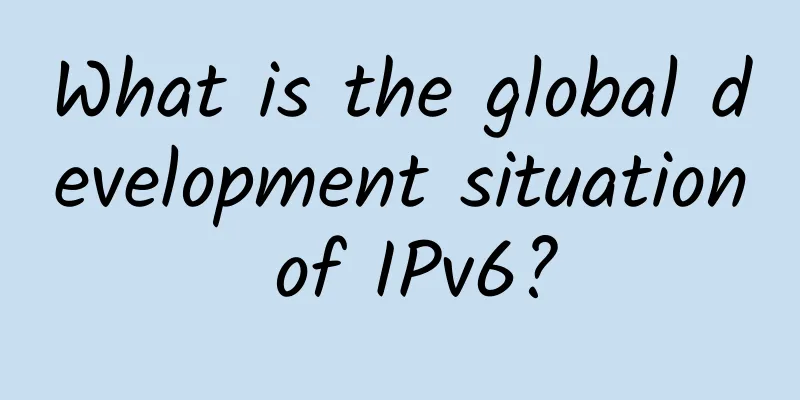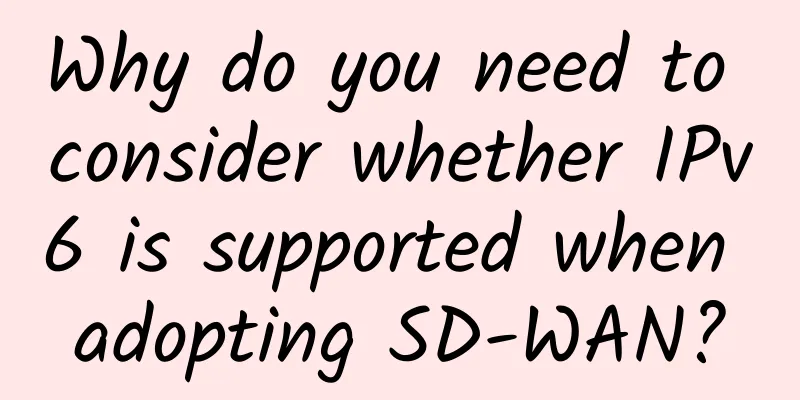What is the global development situation of IPv6?

|
Statistics from authoritative foreign organizations show that IPv6 deployment has been advancing rapidly around the world in recent years. The IPv6 deployment rate in major developed countries has continued to increase steadily, and some developing countries have made rapid progress. The IPv6 deployment rate in countries such as Belgium and the United States has exceeded 50%. Google's global IPv6 user visits account for 25%, and the world's top websites such as Google and Facebook have fully supported IPv6. 1. IPv6 construction is accelerating 1. The number of IPv6 users is huge, and the number of active users has increased significantly According to APNIC statistics on April 30, 2019, IPv6 users accounted for 15.97% of the world's 3483,790,681 (3.48 billion) Internet users. So far, the number of IPv6 users worldwide is about 556,207,093 (556 million). As of April 2019, the proportion of users accessing Google websites via IPv6 has risen to about 25%, an increase of 5 percentage points from 20% at the beginning of 2018. 2. IPv6 network traffic has experienced rapid growth, but has remained stable in the near future Data from AMS-IX in Amsterdam, the Netherlands, shows that IPv6 network traffic has grown rapidly since July 2018, with average traffic increasing from approximately 70Gbps in July 2018 to 138Gbps in April 2019. The large scale of IPv6 users and increasingly improved IPv6 network infrastructure have laid a solid foundation for the rapid increase in IPv6 traffic. However, the role of IPv6 content and applications in driving traffic should not be underestimated. The relatively lagging transformation of IPv6 website applications has become a key factor hindering the continued rapid growth of IPv6 traffic. 3. The number of IPv6 address applications has increased year by year, and countries are paying more attention to IPv6 The number of IPv6 address applications is a major indicator of IPv6 basic resources. With the rapid development of industries such as the Internet of Things and the Industrial Internet and the increasingly urgent need for network security, countries have accelerated the pace of applying for IPv6 addresses. According to APNIC data, as of May 1, 2019, the total number of IPv6 address applications worldwide has reached 557,268 blocks (/32), while the total number of IPv6 address applications worldwide in the same period last year was 464,525 blocks (/32), an increase of about 20 percentage points. The number of IPv6 address applications intuitively reflects the attitudes of various countries towards IPv6 and the reserves of address resources. At present, the number of IPv6 address applications in my country has maintained a rapid growth, and the total number of IPv6 address resources has reached 47,263 blocks (/32), ranking first in the world. 4. Operators actively promote IPv6 transformation of network infrastructure, and mobile network IPv6 deployment is far ahead Data from 335 network operators released by World IPv6 Launch show that major operators around the world are actively promoting the transformation of IPv6 network infrastructure. Overall, the deployment rate of IPv6 is on the rise. In April 2019, Japan's KDDI's IPv6 deployment rate was 48.70%, up about 6 percentage points from the same period last year. The IPv6 deployment rate of Comcast in the United States was 67.11%, up about 7 percentage points from the same period last year.
At the same time, based on VoLTE's natural dependence on IPv6, mobile operators have set IPv6 priority when deploying VoLTE, which not only greatly increases the deployment rate of network IPv6, but also lays a solid foundation for the rapid increase of IPv6 traffic due to the huge scale of IPv6 users and the perfect IPv6 network. The IPv6 deployment rate of India's Reliance JIO exceeds 90%, the IPv6 deployment rate of Verizon Wireless in the United States is about 86%, the IPv6 deployment rate of Sprint is about 78%, and the IPv6 deployment rate of T-Mobile USA is about 92%. 5. Website application support rate tends to be stable, and IPv6 content construction gradually becomes the focus of promotion As of April 2019, according to data provided by World IPv6 Launch, the support rate for IPv6 among the top 1000 websites ranked by Alexa has stabilized at around 25% this year. Google, YouTube, and Facebook, the top three websites in the world, have fully supported IPv6. According to statistics from Vyncke in May 2019, more than 20 of the top 50 websites in the United States ranked by Alexa support IPv6. After nearly two years of development, the number of websites supporting IPv6 in Belgium has also increased from single digits to around 20. Although content providers such as Google and Facebook have been committed to providing IPv6 support at the content layer, the transformation of domestic websites, consumer-oriented applications, and some company internal systems to IPv6 is still a huge project. Even in Japan, which ranks high in deployment rate, only 5 of the top 50 websites in Japan ranked by Alexa support IPv6. IPv6 content construction has gradually become a key task for the continued promotion of large-scale deployment of IPv6. II. Advanced Experience of Various Countries in Promoting IPv6 Deployment
1. IPv6 deployment in major developed countries is still progressing steadily at a high level, while some developing countries are developing rapidly, with different promotion models. Based on APNIC statistics in April 2019, the global IPv6 deployment rate has reached 20.95%, up about 2 percentage points from 18.86% at the beginning of the year. Developed countries in North America and Europe have maintained their usual high deployment rates. Belgium's IPv6 deployment rate is 57.83%, up about 6 percentage points from 51.85% at the beginning of the year, still ranking first. The United States' IPv6 deployment rate is 53.25%, up about 6 percentage points from 46.98% at the beginning of the year, ranking second. Five Asian countries and regions, including India, Malaysia, Vietnam, Japan and Taiwan, China, are among the top ten in the world. Vietnam's IPv6 deployment rate is 34.94%, up about 5 percentage points from 30.21% at the beginning of the year, ranking seventh. China's deployment rate is 10.80%, ranking 44th, up about 4 percentage points from 6.92% at the beginning of the year, moving up 3 places. 2. Based on the experience of countries with the highest IPv6 deployment rates: Active advocacy by the government, strong support from the expert working group and vigorous promotion by operators are the prerequisites for the rapid deployment of IPv6. The United States' "Government IPv6 Application Guide/Planning Roadmap", India's "National IPv6 Deployment Roadmap", Vietnam's "National IPv6 Action Plan", etc., have all effectively guided and supported the large-scale deployment of IPv6 in their own countries; Japan's JPNIC, IPv6 Promotion Committee and Vietnam's VNNIC, National IPv6 Working Group and other expert working groups in various countries have played an important role in promoting and supporting the large-scale deployment of IPv6 in their own countries by vigorously advocating, organizing and coordinating the cooperation of all sectors of the industry and providing technical support; the IPv6 deployment rate of Japanese operator KDDI has reached about 50%, and American mobile operators such as Verizon Wireless, AT&T and T-Mobile have all set IPv6 priority when deploying VoLTE, thereby building a large scale of IPv6 users and a complete IPv6 network, and the rapid increase in the IPv6 deployment rate is a natural result. Seize the opportunity of technology upgrades and network equipment updates to promote the large-scale deployment of IPv6 in a more economical and efficient manner. Japan's KDDI's FTTH has fully supported IPv6 since September 2014. Vietnam's FPT Telecom and VNPT are pioneers in IPv6 deployment in the fixed broadband field. VNPT is actively deploying 4G LTE to provide IPv6 services and has proposed a deployment plan that only supports IPv6 in the future. Indian mobile operator Reliance Jio has fully supported IPv6 since the beginning of its deployment and has vigorously developed IPv6 users, with an IPv6 deployment rate of over 90%. As the 5G era is approaching, IoT technology is becoming more mature, and information security needs are becoming more urgent, it is undoubtedly a wise move to seize the best opportunity to upgrade technology and update network equipment to promote the large-scale deployment of IPv6. After the rapid increase in IPv6 deployment rate, IPv6 content application transformation has become the focus of IPv6 promotion in various countries. For the United States, which has deployed IPv6 earlier and has a far-leading deployment rate, according to the USG v6 development monitoring project established by the government, the current support for IPv6 on websites of enterprises and research institutions is still far behind that of US government websites; Vietnam actively promotes the support of government agency websites for IPv6, marks IPv6-ready logos on websites that support IPv6, and promotes IPv6 applications; all sectors of Japan are also actively carrying out research work to promote the popularization of IPv6 applications. 3. Conclusion The large-scale deployment of IPv6 requires comprehensive consideration of multiple factors such as technology maturity, financial reserves, and human resources. While ensuring stable service quality, IPv6 transformation needs to balance the contradiction between long-term interests and the immediate costs of transformation investment, so as to achieve efficient, economical, scientific and smooth transition of large-scale deployment of IPv6. |
<<: Why 5G will not have a big impact on people
Recommend
RAKsmart New Year's Big Offer: E3 servers starting at $30/month, new Korean servers, Hong Kong/Japan/US cluster servers, VPS monthly payment starting at $1.99, GPU servers, high-defense servers
RAKsmart has launched a New Year's Big Sale. ...
Why edge computing is central to the development of the Internet of Things
Many connected devices today are able to take adv...
How managed services can make the most of IoT
IoT products are everywhere—or at least they will...
Huawei China ICT Ecosystem Tour 2018 successfully concluded, calling on partners to create a prosperous ecosystem
[Original article from 51CTO.com] From late sprin...
RAKsmart: Japan/Korea independent server replenishment, large bandwidth, unlimited traffic, CN2+BGP line
At the beginning of the month, I shared RAKsmart&...
Three-minute review! A quick overview of 5G industry development trends in November 2021
After the rapid development in 2020, 2021 is a cr...
Academician Wu Hequan: 5.5G does not require full network coverage, and recommends joint construction and sharing
IT Home reported on December 7 that the 2023 Worl...
API Gateway: Layer 8 Network
An API is a set of rules that govern the exchange...
To prevent 5G from the barrel effect, both Sub-6GHz and millimeter wave are indispensable
The wooden barrel effect is a well-known truth. 5...
DogYun National Day Promotion: 30% off on Dynamic Cloud, 20% off on Classic Cloud, 100 yuan/month discount on Dedicated Server, 100 yuan free for every 100 yuan you top up
DogYun is a Chinese hosting company established i...
edgeNAT VPS monthly payment 20% off, annual payment 30% off, US/Hong Kong/Korea VPS monthly payment starts from 48 yuan
edgeNAT has released a regular promotion for this...
What attacks can hackers launch using TCP/IP?
TCP/IP is the most basic communication protocol o...
CloudCone: $17.99/year KVM-1GB/50GB/1TB/Los Angeles MC Data Center
CloudCone sent an email at the beginning of the m...
Created a debuggable gRPC GUI client
[[437208]] This article is reprinted from the WeC...









